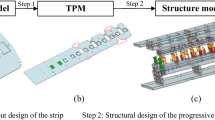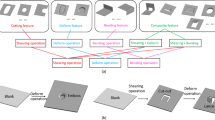Abstract
Nowadays, progressive dies have a special role in various methods of sheet metal production. The design process, however requires a considerable amount of time and expertise. Strip layout design is a key step in progressive die design, therefore automating strip layout has a vital role in Computer Aided Progressive Die Design (CAPDD). In this paper, a mathematical model, based on set theory, is introduced to analyze the problem of strip layout. The model describes the mathematical nature of the strip layout problem and reveals the reason why researchers have always faced problems in optimizing strip layout automatically. Using the model presented, an algorithm is developed to optimize strip layout using the minimum number of stations and the torque equilibrium criteria. A prototype software is also developed to automate strip layout design based on the presented algorithm. The suitability of the model is then demonstrated through industrial examples.
Similar content being viewed by others
References
Chang H., Tsai Y., Chiu K. (2007) A novel optimal working process in the design of parametric progressive dies. Journal of Advanced Manufacturing Technology 33: 915–928
Choi J. C., Kim B. M., Kim C., Lee S. M. (1996) An automated process planning die design system for blanking of stator and rotor parts. Journal of the Korean Society of Precision Engineering 13: 40–51
Choi J. C., Kim B. M., Kim C., Kim J. H. (1997a) An automated process planning system for blanking and piercing of stator and rotor parts and irregular shaped sheet metal products. Journal of the Korean Society of Precision Engineering 1 13: 46–53
Choi J. C., Kim B. M., Cho H. Y., Kim C. (1997b) An automated die design system for blanking or piercing of stator and rotor parts. Journal of the Korean Society of Precision Engineering 1 14: 22–23
Choi J. C., Kim B. M., Cho H. Y., Kim C., Kim J. H. (1998a) An integrated CAD system for the blanking of irregular-shaped sheet metal products. Journal of Materials Processing Technology 83: 84–97
Choi J. C., Kim B. M., Cho H. Y., Kim C., Kim J. H. (1998b) A compact and practical CAD system for blanking or piercing of irregular-shaped sheet metal products and stator and rotor parts. International Journal of Machine Tools and Manufacture 38: 931–963
Choi J. C., Kim C. (2001) A compact and practical CAD/CAM system for the blanking or piercing of irregular shaped-sheet metal products for progressive working. Journal of Materials Processing Technology 110: 36–46
Choi J. C., Kim C., Kim J. H. (2002a) A study of the progressive working of an electric product using a 3D Shape recognition method. International Journal of Advanced Manufacturing Technology 19: 525–536
Choi J. C., Kim C., Kim J. H., Kim Y. M. (2002b) Development of a system for progressive working of an electric product by using fuzzy set theory. International Journal of Advanced Manufacturing Technology 20: 765–779
Dequan Y., Rui Z., Jun C., Zhen Z. (2006) Research of knowledge-based system for stamping process planning. International Journal of Advanced Manufacturing Technology 29: 663–669
Fogg B., Jaimeson B. (1975) The influencing factors in optimizing press tool die layout and a solution computer aids. CIRP Annals 24: 429–434
Ghatrehnaby M., Arezoo B. (2009) A fully automated nesting and piloting system for progressive dies. Journal of Materials Processing Technology 209: 525–535
Ghatrehnaby M., Arezoo B. (2010) Automatic piloting in progressive dies using medial axis transform. Applied Mathematical Modelling 34: 2981–2997
Hankin, R. K. S., & West, L. J. (2007). Set partitions in R. Journal of statistical software, December, 23.
Ingarao G., Lorenzo R. (2010) A new progressive design methodology for complex sheet metal stamping operations: Coupling spatially differentiated restraining forces approach and multi-objective optimization. Computers and Structures 88: 625–638
Jia, Z., Li, H., Zhang, X., Wu, H., & Fang, M. (2009). Study on the correlated design method of plate holes for progressive dies based on functional feature. International Journal of Advanced Manufacturing Technology. doi:10.1007/s00170-009-2371-6.
Jagirdar, R. (1995). Set theoretic and graph based approach for automatic feature recognition of sheet metal components. Ph.D. thesis, Indian Institute of Technology Kanpur, Kanpur.
Kumar S., Singh R. (2004) A low cost knowledge base system framework for progressive die design. Journal of Materials Processing Technology 153–154: 958–964
Kumar S., Singh R. (2007a) A short note on an intelligent system for selection of materials for progressive die components. Journal of Materials Processing Technology 182: 456–461
Kumar S., Singh R. (2007b) An intelligent system for automatic modeling of progressive die. Journal of Materials Processing Technology 194: 176–183
Kumar S., Singh R. (2008) Automation of strip-layout design for sheet metal work on progressive die. Journal of Materials Processing Technology 195: 94–100
Lin Z. C., Deng C. H. (2001) Analysis of a torque equilibrium model and the optimal Strip working sequence for a shearing-cut and bending progressive die. Journal of Material Processing and Technology 115: 302–312
Lin Z. C., Chen C. (2003) The application of the moment equilibrium model to the offset of pressure center of trimming progressive die in IC packaging machine. Journal of Materials Processing Technology 140: 653–661
Murakami, H., Shirai, K., Yamada, O., & Isoda, K. (1980). A CAD system for progressive dies. In Proceedings of 21st Machine Tool Design and Research Conference, McMillan, London (pp. 687–592).
Murakami, H., & Shirai, K. (1984). CAD system for press tools. In Proceedings of International Symposium on Design and Synthesis, Tokyo, Japan, (11–13 July) (pp. 86–91).
Ramana K. V., Rao P. V. M. (2004a) Data and knowledge modeling for design-process planning integration of sheet metal components. Journal of Intelligent Manufacturing 15: 607–623
Ramana, K. V., & Rao, P. V. M. (2004b). A SYSTEM LEVEL MODELING FOR SHEET METAL PROCESS PLANNING, ASME 2004 Design Engineering Technical Conferences and Computers and Information in Engineering Conference September 28-October 2, Salt Lake City, Utah USA.
Ramana K. V., Rao P. V. M. (2005) Automated manufacturability evaluation system for sheet metal components in mass production. International Journal of Production Research 43(18): 3889–3913
Rosen K. H., Michaels J. G., Gross J. L., Grossman J. W., Shier D. R. (2000) Handbook of discrete and combinatorial mathematics. CRC Press LLC, Boca Raton
Schaffer G. (1971) Computer design of progressive dies. American Machinist 22: 73–75
Shirai K., Murakami H. (1985) Development of a CAD:CAM system for progressive dies. American Annals of the CIRP 34(1): 187–190
Shirai K., Murakami H. (1989) A compact and practical CAD/CAM system for progressive die. Bulletin of the Japanese Society of Processing Technology 23(1): 25–30
Tor S. B., Britton G. A., Zhang W. Y. (2005) Development of an object-oriented blackboard model for stamping process planning in progressive die design. Journal of Intelligent Manufacturing 16: 499–513
Tor S. B., Britton G. A., Zhang W. Y. (2003) Indexing and retrieval in metal stamping die design using case-based reasoning. Journal of Computing and Information Science in Engineering, ASME 3(4): 353–362
Vosniakos G. C., Segredou I., Gianakakis T. (2005) Logic programming for process planning in the domain of sheet metal forming with progressive dies. Journal of Intelligent Manufacturing 16: 479–497
Zhibing Z., Yuqi L., Ting D., Zhigang L. (2008) Blank design and formability prediction of complicated progressive die stamping part using a multi-step unfolding method. Journal of Materials Processing Technology 205: 425–431
Author information
Authors and Affiliations
Corresponding author
Rights and permissions
About this article
Cite this article
Ghatrehnaby, M., Arezoo, B. Automatic strip layout design in progressive dies. J Intell Manuf 23, 661–677 (2012). https://doi.org/10.1007/s10845-010-0417-0
Received:
Accepted:
Published:
Issue Date:
DOI: https://doi.org/10.1007/s10845-010-0417-0




